




********************************************************************
MELBOURNE CONNECT: ENVIRONMENTAL GRAPHICS
Practice Lab
Ethan Tsang
Mia Murone
Georgia Hodgkinson
Danny Butt
Commisioned Artist
Dr. Ngardarb Francine Riches with Pastor Tony Riches
Faculty of Engineering and IT
Richard Gillespe
Jeremy Elias
Sarah Nickas
Production
Blueprint
MELBOURNE CONNECT: ENVIRONMENTAL GRAPHICS
Practice Lab
Ethan Tsang
Mia Murone
Georgia Hodgkinson
Danny Butt
Commisioned Artist
Dr. Ngardarb Francine Riches with Pastor Tony Riches
Faculty of Engineering and IT
Richard Gillespe
Jeremy Elias
Sarah Nickas
Production
Blueprint
*************
These environmental graphics
stage
the Seven Sisters story across seven levels of circulation spaces and
workspaces at Melbourne Connect. Our graphics celebrate the flora and fauna that reflect the lives and environments of the Seven Sisters. Listening to Dr Ngardarb Francine Riches tell
her version of the Dreamtime story, we were inspired by the natural and Dreamtime environments of the Seven Sisters, and it would make us wonder about a relationship between Dreamtime and technology.
In collaboration with Dr Riches, she proposed the Kimberley flora and fauna that she grew up with as natural reference, and she would encourage us to tell our own version of the story through our own graphic language.
Ultimately, our graphics reflect this sharing. They depict mediations of relationships that are often considered contrary.
--
In this initialising project of Practice Lab, the Faculty of Enginnering and IT (FEIT) approached Practice Lab to develop designerly interventions for the passageways of their new faculty building at the Melbourne Connect precinct. The faculty building spans 7 floors and houses FEIT postgraduate researchers and various IT departments in a state-of-the-art research environment. The building co-exists in the precinct with the Telstra Creator Space and The Science Gallery, as well as an early learning centre and postgraduate student accomodation which connect to the faculty building via Superfloors; expansive communal spaces.
Our aim for this project was to create graphics that represent design, technology and research, appriopriate for all the different tenants of the precinct. At the time - mid-pandemic -, vitrines were being installed in the building which are curated and presented by Dr. Richard Gillespe, curator of heritage collections at FEIT - whom also comissioned the project with us to begin with. These vitrines celebrated Australian technological contributions, displaying artefacts such as the IBM 7044 data processing system and the door to CSIRAC; Australia’s first digital computer. Referencing for our graphics started there.
In addition, Richard put forward an aim to explore a reflection of the history of the site and land, with the precinct occupying Woi wurrung land and locating on the former site of the Royal Women’s Hospital. This institution participated in forcibly removing Aboriginal and Torres Strait Islander babies from their mothers and families, resulting in the Stolen Generations, proceeding an enduring impact on the lives of First Nations people. Fast forward to the building today; a site of technological breakthrough, and the timeline in-between seems vast and barren.
---
The Icon as Technology
Our intial design proposal featured digital icons inspired by the technological environments of the Melbourne Connect building. We explored the icon as technology where technological and scientific logics informed the engineering of our icon system by means of function-led form-making; duplication, multiplication, symmetry and circuitry.
![]()
![]() Icon system developed by Georgia Hodgkinson
Icon system developed by Georgia Hodgkinson
These turned into corridor-long compositions that spanned walls to fully accompany thoroughfare.
---
Dr. Ngardarb Riches
At the same time, a collaboration was developing with Dr. Ngardarb Riches, an indigenous artist and researcher who was at the time, working on an art project for the new student precinc on the University main campus. For that project, Ngardarb told the story of the Seven Sisters, a story passed down by her grandparents and old people, from her ancestors:
Proceedingly, Ngardarb - and Tony; together being Specialised Indigenous Services - was comissioned to join and advise our graphic project, while also an artwork to be produced by Ngardarb and Tony was comissioned to be hung on the 7th floor of the Melbourne Connect Building. Our project had a new aim: to support Ngardarb’s and Tony artwork, and so; to stage the story of the Seven Sisters across the 7 floors of the FEIT building.
--
Listening to Dr Ngardarb Francine Riches tell
her version of the Dreamtime story, we were inspired by the natural and Dreamtime environments of the Seven Sisters. We started to wonder about a relationship between Dreamtime and technology.
The Seven Sisters, who have died and gone from the land, through the sea, and into the sky. They are seen in the stars known as the Pleiades constellation.
Though different names for, the Seven Sisters story and astronomy arrive at the same fascination. Furthermore, they both use the star formations in the same way - technologically.
Still today, the Seven Sisters are seen in the night sky and during winter-time or the dry season they will disappear for some time. This is when they have jumped into the ocean!
In examining our working project, Ngardarb proposed the Kimberley flora and fauna that she grew up with as natural reference. She would also encourage us to tell our own version of the story through our own graphic language.
Followingly, we started to develop icons that reference the form of the Kimberley flora and fauna.
![1. The Seven Sisters Campfire and Flowers of the woolewoorrngor, Darwin woollybutt]()
![2. The Flower of the Yellow Kapok Tree]()
![3. Rainbow Plant]()
![4. Bachelor's Button]()
![5. The Kimberly Star]()
![6. The sea of the Kimberley coast]()
![7. The journey of the Seven Sisters]()
The environmental graphics on each level represent our response to elements of the Kimberley landscape.
1. Flowers of the woolewoorrngor Darwin woollybutt, common through the open forests of the Kimberley
2. The edible flower of the Yellow Kapok tree
3. Rainbow plant, a carnivorous plant of northern Australia that germinates after fire
4. Bachelor’s Button, a wildflower of the Kimberley
5. New flowers arrive in the Kimberley; a local variety of the introduced frangipani is called the Kimberley Star
6. The sea of the Kimberley coast
7. The journey of the Seven Sisters
![]()
In collaboration with Dr Riches, she proposed the Kimberley flora and fauna that she grew up with as natural reference, and she would encourage us to tell our own version of the story through our own graphic language.
Ultimately, our graphics reflect this sharing. They depict mediations of relationships that are often considered contrary.
--
In this initialising project of Practice Lab, the Faculty of Enginnering and IT (FEIT) approached Practice Lab to develop designerly interventions for the passageways of their new faculty building at the Melbourne Connect precinct. The faculty building spans 7 floors and houses FEIT postgraduate researchers and various IT departments in a state-of-the-art research environment. The building co-exists in the precinct with the Telstra Creator Space and The Science Gallery, as well as an early learning centre and postgraduate student accomodation which connect to the faculty building via Superfloors; expansive communal spaces.
Our aim for this project was to create graphics that represent design, technology and research, appriopriate for all the different tenants of the precinct. At the time - mid-pandemic -, vitrines were being installed in the building which are curated and presented by Dr. Richard Gillespe, curator of heritage collections at FEIT - whom also comissioned the project with us to begin with. These vitrines celebrated Australian technological contributions, displaying artefacts such as the IBM 7044 data processing system and the door to CSIRAC; Australia’s first digital computer. Referencing for our graphics started there.
In addition, Richard put forward an aim to explore a reflection of the history of the site and land, with the precinct occupying Woi wurrung land and locating on the former site of the Royal Women’s Hospital. This institution participated in forcibly removing Aboriginal and Torres Strait Islander babies from their mothers and families, resulting in the Stolen Generations, proceeding an enduring impact on the lives of First Nations people. Fast forward to the building today; a site of technological breakthrough, and the timeline in-between seems vast and barren.
---
The Icon as Technology
Our intial design proposal featured digital icons inspired by the technological environments of the Melbourne Connect building. We explored the icon as technology where technological and scientific logics informed the engineering of our icon system by means of function-led form-making; duplication, multiplication, symmetry and circuitry.
These turned into corridor-long compositions that spanned walls to fully accompany thoroughfare.
---
Dr. Ngardarb Riches
At the same time, a collaboration was developing with Dr. Ngardarb Riches, an indigenous artist and researcher who was at the time, working on an art project for the new student precinc on the University main campus. For that project, Ngardarb told the story of the Seven Sisters, a story passed down by her grandparents and old people, from her ancestors:
There were seven sisters who had
three husbands between them and many children. The story is told that the sisters
went out to gather food from the bush like berries, roots, and wild honey. The husbands
went hunting for turtle, dugong and fish.
The children were asked to take care of the fire, which had to be maintained constantly for cooking and warmth. But while the parents were away hunting and gathering food, the children decided that they would not keep the fire burning and would hide the firewood.
When the sisters came back and saw what had happened, they were angry and upset that the children had allowed the fire to go out.
It was winter-time, when the ocean in the Kimberley remains warm. So the sisters went into the ocean seeking warmth. When the husbands came, they too went into the ocean, with the children not far behind. It is said that they died, went up into the sky and turned into stars.
The children were asked to take care of the fire, which had to be maintained constantly for cooking and warmth. But while the parents were away hunting and gathering food, the children decided that they would not keep the fire burning and would hide the firewood.
When the sisters came back and saw what had happened, they were angry and upset that the children had allowed the fire to go out.
It was winter-time, when the ocean in the Kimberley remains warm. So the sisters went into the ocean seeking warmth. When the husbands came, they too went into the ocean, with the children not far behind. It is said that they died, went up into the sky and turned into stars.
Proceedingly, Ngardarb - and Tony; together being Specialised Indigenous Services - was comissioned to join and advise our graphic project, while also an artwork to be produced by Ngardarb and Tony was comissioned to be hung on the 7th floor of the Melbourne Connect Building. Our project had a new aim: to support Ngardarb’s and Tony artwork, and so; to stage the story of the Seven Sisters across the 7 floors of the FEIT building.
--
Listening to Dr Ngardarb Francine Riches tell
her version of the Dreamtime story, we were inspired by the natural and Dreamtime environments of the Seven Sisters. We started to wonder about a relationship between Dreamtime and technology.
The Seven Sisters, who have died and gone from the land, through the sea, and into the sky. They are seen in the stars known as the Pleiades constellation.
Though different names for, the Seven Sisters story and astronomy arrive at the same fascination. Furthermore, they both use the star formations in the same way - technologically.
Still today, the Seven Sisters are seen in the night sky and during winter-time or the dry season they will disappear for some time. This is when they have jumped into the ocean!
In examining our working project, Ngardarb proposed the Kimberley flora and fauna that she grew up with as natural reference. She would also encourage us to tell our own version of the story through our own graphic language.
Followingly, we started to develop icons that reference the form of the Kimberley flora and fauna.


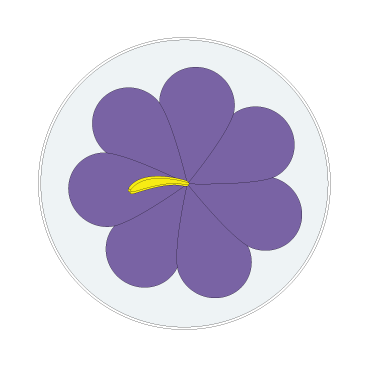
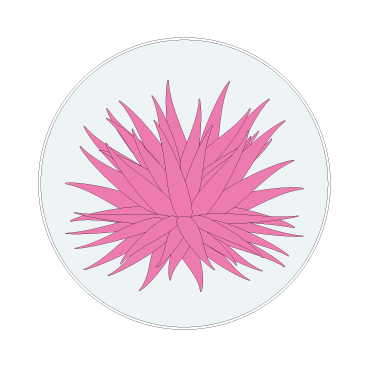



The environmental graphics on each level represent our response to elements of the Kimberley landscape.
1. Flowers of the woolewoorrngor Darwin woollybutt, common through the open forests of the Kimberley
2. The edible flower of the Yellow Kapok tree
3. Rainbow plant, a carnivorous plant of northern Australia that germinates after fire
4. Bachelor’s Button, a wildflower of the Kimberley
5. New flowers arrive in the Kimberley; a local variety of the introduced frangipani is called the Kimberley Star
6. The sea of the Kimberley coast
7. The journey of the Seven Sisters
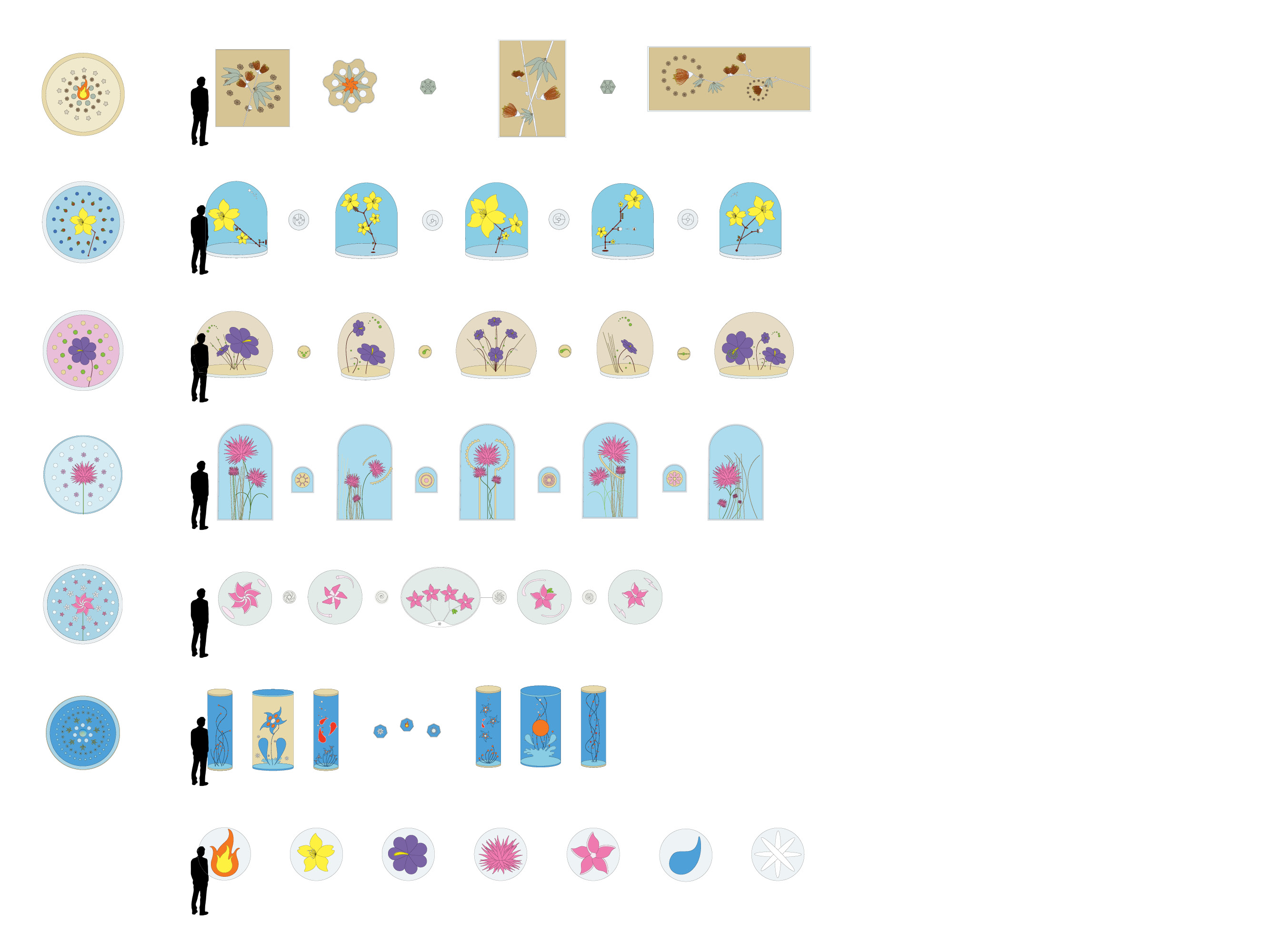








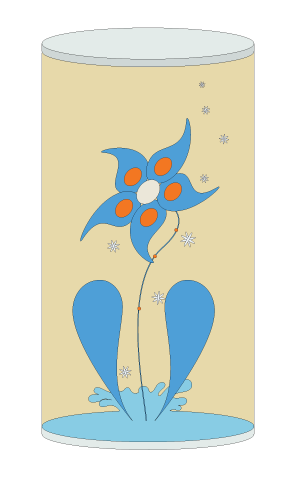
*********************************************************************
EXTERIOR ARTWORKS FOR RECORDING PODS
Practice Lab
Ethan Tsang
Danny Butt
Prize Designers 2021
Kiara Allis
Savannah Lysaught
Milly Hines
Prize Designers 2022
Alice Tai
Matilda Carlberg
Southbank Library
Ben Loveridge
Graphic Design Capstone Staff
Ela Egidy
Narelle Desmond
Production
Visual Graphics
EXTERIOR ARTWORKS FOR RECORDING PODS
Practice Lab
Ethan Tsang
Danny Butt
Prize Designers 2021
Kiara Allis
Savannah Lysaught
Milly Hines
Prize Designers 2022
Alice Tai
Matilda Carlberg
Southbank Library
Ben Loveridge
Graphic Design Capstone Staff
Ela Egidy
Narelle Desmond
Production
Visual Graphics
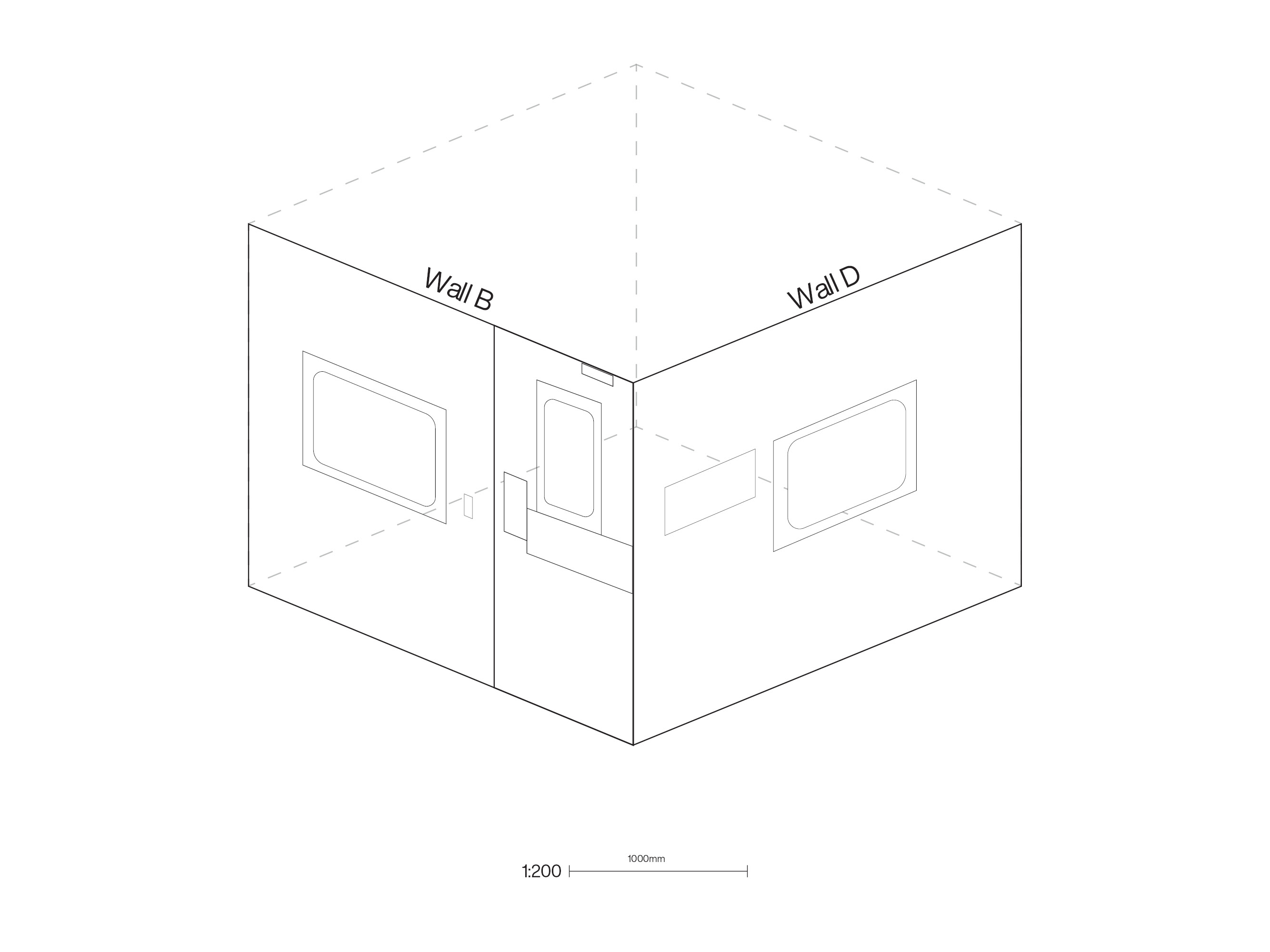
To accompany their new pre-fabricated recording pods, the Southbank Library approached Practice Lab for a design solution to decorate the stark white exterior of such pods.
Considering the nature of the project, Practice Lab proposed contribution from the Graphic Design undergraduate Capstone class students in which Practice Lab could support adminstratively. This included legalities, finanical arrangements, file management, and production liaising. And so, a competition was organised in accordance with the subject coordinators that offered a layout template for Capstone students to submit a proposed design according to the dimensions of the pod. The requirements of the brief led the submitting student towards common industry parameters that a graphic designer often practices within: the design should be appropriate to the context - the library and complementary of University visual material - and appriopriate to the production process. Articulations of their designs, such as concept statements, were also apparent to the judging process.
In 2021, a large volume of engaging submissions led to the extension of project where two additional recording pods were elected for application. Kiara Allis’ mural-like design and was selected for the Southbank Library Recording pod. Savannah Lysaught’s design externalised the calm of the sound-proof feature of the recording pod, and was nominated to adorn the Giblin Euson recording pod, along with an extension of the design onto a secondary pod. Milly Hines’ design highlighted the casette tape as a archival physical medium, which sits aptly on the Bailleu Library recording pod alongside the rows of catalogued books.
In 2022, the groundwork from the 2021 competition allowed the project to run again onto two additional pre-fabricated recording pods; one on the Dookie campus in rural Victoria, and an additional pod in the Bailleu Library. Alice Tai’s delightful submission has been selected to decorate the Dookie library recording pod. Matilda Carlberg’s city skyline design impressed with its notable tonal work, and has been selected to adorn the additional Bailleu library recording pod.
Considering the nature of the project, Practice Lab proposed contribution from the Graphic Design undergraduate Capstone class students in which Practice Lab could support adminstratively. This included legalities, finanical arrangements, file management, and production liaising. And so, a competition was organised in accordance with the subject coordinators that offered a layout template for Capstone students to submit a proposed design according to the dimensions of the pod. The requirements of the brief led the submitting student towards common industry parameters that a graphic designer often practices within: the design should be appropriate to the context - the library and complementary of University visual material - and appriopriate to the production process. Articulations of their designs, such as concept statements, were also apparent to the judging process.
In 2021, a large volume of engaging submissions led to the extension of project where two additional recording pods were elected for application. Kiara Allis’ mural-like design and was selected for the Southbank Library Recording pod. Savannah Lysaught’s design externalised the calm of the sound-proof feature of the recording pod, and was nominated to adorn the Giblin Euson recording pod, along with an extension of the design onto a secondary pod. Milly Hines’ design highlighted the casette tape as a archival physical medium, which sits aptly on the Bailleu Library recording pod alongside the rows of catalogued books.
In 2022, the groundwork from the 2021 competition allowed the project to run again onto two additional pre-fabricated recording pods; one on the Dookie campus in rural Victoria, and an additional pod in the Bailleu Library. Alice Tai’s delightful submission has been selected to decorate the Dookie library recording pod. Matilda Carlberg’s city skyline design impressed with its notable tonal work, and has been selected to adorn the additional Bailleu library recording pod.



Kiara Allis, Southbank Library, 2021.



Milly Hines, Bailleu Library, 2021.

Alice Tai, Dookie Library, 2022 (Upcoming)

Matilda Carlberg, Bailleu Library, 2022 (Upcoming)
********************************************************************
UNIVERSITY HOUSE 70th ANNIVERSARY EXHIBITION
Practice Lab
Ethan Tsang
Danny Butt
UoM Museum and Collections: Interns
Flora Harpley
Sarah Ning
UoM Museum and Collections Helen Arnoldi
Jason Benjamin
University House
John Macaulay
Production
VCA Digital Printing: Andrew McLaughlin
Neo Frames
Classic Colour Copy
UNIVERSITY HOUSE 70th ANNIVERSARY EXHIBITION
Practice Lab
Ethan Tsang
Danny Butt
UoM Museum and Collections: Interns
Flora Harpley
Sarah Ning
UoM Museum and Collections Helen Arnoldi
Jason Benjamin
University House
John Macaulay
Production
VCA Digital Printing: Andrew McLaughlin
Neo Frames
Classic Colour Copy

In commission of their 70th Anniversary exhibition, University House coordinated with The University of Melbourne Museum and Collections and their interns to curate a selection of artworks in highlight of The University of Melbourne’s history. Among the curation are artworks from The Univeristy of Melbourne Art Collection, from artists such as Ludwig Hirschfeld-Mack and Ralph Balson, as well as photography from Wolfgang Sievers.
Practice Lab was enlisted to liaise the production of the curation and manage the project overall, including image preperation and description design. Label motifs were drawn from the mosaic facade by Leonard French (1956) that currently runs along the Beaurepaire Centre across from University House.
Practice Lab, along with Museum and Collections interns; Flora and Sarah, worked to provide a high clarity exhibition. The narrative in the selection of works are carried through in the layout of the hang, with support from the detailed descriptions of the labels and their accompanying motifs.
The expertise of the producers and installers were vital in bringing together a high-quality but cost-effective result. The design considerations of the pre-production stage were really enabled by the material knowledge and pratical nuances of the technicians, leading to a smooth production phase and a particularly appropriate final result.
Practice Lab was enlisted to liaise the production of the curation and manage the project overall, including image preperation and description design. Label motifs were drawn from the mosaic facade by Leonard French (1956) that currently runs along the Beaurepaire Centre across from University House.
Practice Lab, along with Museum and Collections interns; Flora and Sarah, worked to provide a high clarity exhibition. The narrative in the selection of works are carried through in the layout of the hang, with support from the detailed descriptions of the labels and their accompanying motifs.
The expertise of the producers and installers were vital in bringing together a high-quality but cost-effective result. The design considerations of the pre-production stage were really enabled by the material knowledge and pratical nuances of the technicians, leading to a smooth production phase and a particularly appropriate final result.
Wrapped Artworks
Vinyl Lettering
********************************************************************
VARITIES OF IMAGINATION, CREATIVITY & WELLBEING E-PUBLICATION
Practice Lab
Ethan Tsang
Mia Murone
Georgia Hodgkinson
Danny Butt
Enlightment, Romanticism and Contemporary Culture Research Unit
Anita Archer
Peter Otto
VARITIES OF IMAGINATION, CREATIVITY & WELLBEING E-PUBLICATION
Practice Lab
Ethan Tsang
Mia Murone
Georgia Hodgkinson
Danny Butt
Enlightment, Romanticism and Contemporary Culture Research Unit
Anita Archer
Peter Otto

